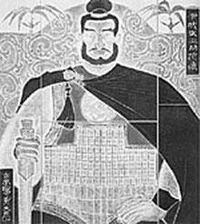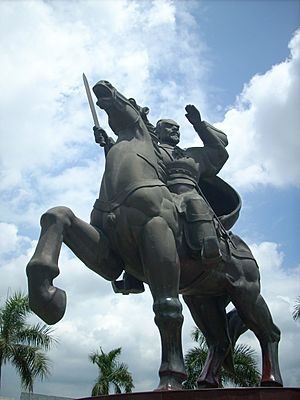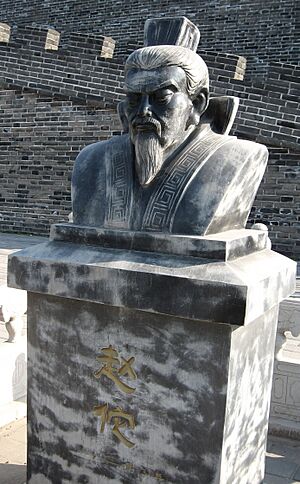Zhao Tuo facts for kids
Quick facts for kids Zhao TuoɖˠiᴇuX dɑ 趙佗 |
|||||
|---|---|---|---|---|---|
| Emperor of Nanyue | |||||

A statue of Emperor Zhao Tuo in Xuân Quan communal temple, Văn Giang District, Hưng Yên Province, Vietnam
|
|||||
| Emperor of Nanyue | |||||
| Reign | 203–137 BC | ||||
| Successor | Zhao Mo (Triệu Mạt) | ||||
| Born | 240 BC Zhengding County, Shijiazhuang, China |
||||
| Died | 137 BC (aged 103) Nanyue |
||||
| Burial | Guangzhou | ||||
|
|||||
| House | Triệu dynasty | ||||
| Zhao Tuo | |||||||||||||||
|---|---|---|---|---|---|---|---|---|---|---|---|---|---|---|---|
| Chinese name | |||||||||||||||
| Traditional Chinese | 趙佗 | ||||||||||||||
| Simplified Chinese | 赵佗 | ||||||||||||||
|
|||||||||||||||
| Vietnamese name | |||||||||||||||
| Vietnamese alphabet | Triệu Đà | ||||||||||||||
| Chữ Hán | 趙佗 | ||||||||||||||
| Emperor Wu | |||||||||||||
|---|---|---|---|---|---|---|---|---|---|---|---|---|---|
| Chinese name | |||||||||||||
| Chinese | 武帝 | ||||||||||||
| Literal meaning | The Martial Emperor | ||||||||||||
|
|||||||||||||
| Vietnamese name | |||||||||||||
| Vietnamese alphabet | Vũ Đế | ||||||||||||
| Chữ Hán | 武帝 | ||||||||||||
Zhao Tuo (also known as Triệu Đà in Vietnamese) was a powerful general from the Qin dynasty in ancient China. He later became the first emperor of a new kingdom called Nanyue. This kingdom was located in what is now southern China and northern Vietnam.
Zhao Tuo helped the Qin dynasty conquer the Baiyue peoples. These groups lived in areas that are now Guangdong, Guangxi, and northern Vietnam. After the Qin dynasty ended, Zhao Tuo created his own independent kingdom of Nanyue. He made its capital in a city called Panyu, which is now Guangzhou. This happened in 204 BCE.
Some historians from Vietnam see Zhao Tuo as an important ruler and the founder of the Triệu dynasty. However, other historians believe he was an invader from another land.
Contents
Early Life and Rise to Power
Zhao Tuo was born around 240 BC in a place called Zhending. This area was part of the ancient Chinese state of Zhao. Today, it is in modern Hebei province, China.
When the state of Zhao was defeated by the powerful Qin state in 222 BC, Zhao Tuo joined the Qin army. He became one of their generals. He helped lead the Qin's conquest of the Baiyue people.
Becoming King of Nanyue
After the Qin conquered the Baiyue lands, they divided the territory into three provinces. These were Guilin, Nanhai, and Xiang. Zhao Tuo became a leader in the Nanhai province.
His military commander, Ren Xiao, became very sick. Before he died, Ren Xiao gave Zhao Tuo some important advice. He told Zhao Tuo not to get involved with the problems of the weakening Qin dynasty. Instead, he suggested Zhao Tuo should create his own independent kingdom. This new kingdom would be centered around the city of Panyu (modern Guangzhou), which was far away and easy to defend.
Ren Xiao gave Zhao Tuo full control as the military commander of Nanhai. After Ren Xiao died, Zhao Tuo quickly took action. He closed off important roads to prevent outsiders from entering. He also removed Qin officials and replaced them with people he trusted.
By the time the Qin dynasty collapsed in 206 BC, Zhao Tuo had also taken control of the Guilin and Xiang provinces. He then declared himself King Wu of Nanyue, meaning "King Wu of the Southern Yue."
Nanyue's Relations with the Han Dynasty
After Zhao Tuo established his kingdom, the new Han dynasty in China wanted to make peace.
Peace with Emperor Gaozu
In 196 BC, the first Han emperor, Emperor Gaozu of Han, sent an official named Lu Jia to Nanyue. Lu Jia officially recognized Zhao Tuo as the king of Nanyue. In return, Zhao Tuo agreed to be a "nominal" subject of the Han. This meant he would officially acknowledge the Han emperor as superior, but still rule his own kingdom.
Conflict with Empress Lü
Later, in 185 BC, officials under Empress Lü (who ruled after Emperor Gaozu) stopped trade with Nanyue. They banned the trade of important goods like iron and horses.
Zhao Tuo was angry about this. He responded by calling himself "Emperor Wu of Nanyue." He then attacked the nearby kingdom of Changsha, taking some border towns. In 181 BC, Empress Lü sent an army to attack Nanyue. However, the soldiers got sick from the heat and dampness. They could not even cross the mountains into Nanyue territory.
Zhao Tuo then started to threaten other nearby kingdoms. These included Minyue, Western Ou, and Luo. After these kingdoms submitted to him, Zhao Tuo began issuing orders just like the Han emperor.
Renewed Peace with Emperor Wen
In late 180 BC, Emperor Wen of Han became the new Han emperor. He tried to make peace with Zhao Tuo. Emperor Wen learned that Zhao Tuo's parents were buried in Zhending. He set aside a town just to take care of their graves. He also gave high positions at the Han court to Zhao Tuo's cousins. The Han army stationed near the Nanyue border was also moved away.
In response, Zhao Tuo stopped calling himself "emperor" when communicating with the Han. However, he continued to use the title of emperor within his own kingdom. Nanyue sent envoys to the Han, bringing gifts. This helped restart the important iron trade.
Conquest of Âu Lạc
Zhao Tuo saw the kingdom of Âu Lạc as an easy and tempting target to conquer. He had already gathered his armies for possible war with the Han dynasty.
The Legend of the Magic Crossbow
The exact details of Zhao Tuo's campaign against Âu Lạc are not fully known. Some old records mention that Zhao Tuo faced difficulties at first but eventually won against King An Dương of Âu Lạc.
A famous legend tells the story of this conquest. It says that King An Dương had a special crossbow with a trigger made from a turtle's claw. This crossbow was said to have magical powers. A wise man named Cao Lỗ supposedly said, "He who is able to hold this crossbow rules the realm; he who is not able to hold this crossbow will perish." This meant the crossbow gave its owner great political power.
Zhao Tuo could not defeat King An Dương on the battlefield because of this magic crossbow. So, he asked for a truce. He sent his son, Zhong Shi, to live with King An Dương. Zhong Shi and King An Dương's daughter, Mỵ Châu, fell in love and got married.
Zhong Shi lived at King An Dương's court. He secretly managed to get his hands on the magic crossbow. He asked Mỵ Châu to show him her father's sacred crossbow. While she did, he secretly swapped its trigger, making it useless. He stole the turtle claw and returned to his father.
With the magic crossbow neutralized, Zhao Tuo launched a new attack on Âu Lạc. This time, he defeated King An Dương. The legend says that a golden turtle appeared and guided King An Dương into a watery realm, saving him from capture.
Nanyue's Control of Âu Lạc
After his victory, Zhao Tuo added the regions of Âu Lạc to his Nanyue kingdom. However, he allowed the local chiefs to continue ruling their people. The royal court of Âu Lạc remained in Cổ Loa.
This was the first time the region of Âu Lạc became part of a larger kingdom ruled by a Chinese leader. Zhao Tuo sent two officials to oversee the Âu Lạc lords. One was in the Red River Delta, which he named Jiaozhi. The other was in the Mã and Cả River areas, named Jiuzhen. Some records suggest he also appointed a king in Cổ Loa to continue leading the Âu Lạc lords. These officials also set up trading posts that could be reached by sea.
Later Life and Legacy
Zhao Tuo died in 137 BC. He was very old, around 103 years old. His grandson, Zhao Mo, became the next ruler of Nanyue.
Zhao Tuo's memorial is located in Tuocheng Town, Longchuan County, Guangdong.
See also
- History of China
- History of Vietnam
- Qin's campaign against the Yue tribes
- Nanyue
- Triệu dynasty
- Phiên Ngung
- Trọng Thuỷ
- Han-Nanyue War
- An Dương Vương
- Âu Lạc
- Phiên Ngung Palace
- Museum of the Mausoleum of King Triệu Mạt
- Luobowan Tomb No.1
- Đông Sơn culture
- Changsha (state)
- Minyue
- Yelang
- Bách Việt



